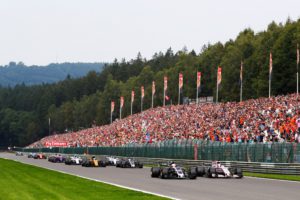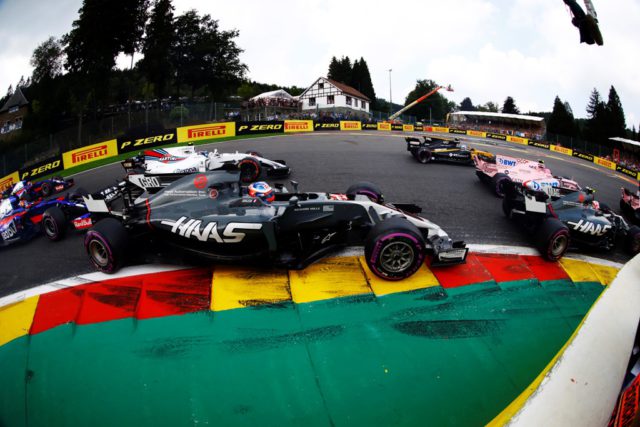Guenther Steiner previews the final European race from the 2017 Formula 1 season. The Haas team principal admits that teams are now trying to focus on 2018, while still chasing points on track.
What’s most important over these next eight races – maximizing Haas F1 Team’s place in the championship or working toward next year?
“We’re working toward next year while still focusing on this year to make as many points as possible. The main focus now back in the factory is next year, but at the racetrack we’re always trying to get the best out of this year’s car and try to get points.”
 As the factory shifts focus to next year, do you expect performance to drop off this year or do you expect all the teams around you to be doing something similar to where performance mirrors what it’s been so far this year?
As the factory shifts focus to next year, do you expect performance to drop off this year or do you expect all the teams around you to be doing something similar to where performance mirrors what it’s been so far this year?
“I don’t think our performance will drop off. I think the performance of some of the other teams will go up because there is no reason why we should drop off. If the other teams get better, we stay the same and that’s how we fall behind. I think the bigger teams will perform well and while we’ll still put effort into this year, the amount of development work we’re doing for 2017 is getting smaller and smaller. Everybody is now trying to focus on 2018. I don’t know what other teams have in the pipeline that’s still to come for this year, but I think the focus for most everyone in the midfield is 2018.”
What are some of the more difficult aspects of next year’s car design?
“It’s hard every year to make a better car, but this year one of the design challenges will be the weight. Putting the halo on adds around 10 kilos (22 pounds). We are not underweight, and very few teams are underweight by 10 kilos this year, so to not increase the weight of the car will be very difficult. Everyone is in the same boat, so you just have to do the best you can, just like every year. But there is no one specific challenge other than the increased weight because of the halo.”
How does Haas F1 Team improve both in the short term and the long term?
“In the short term, we just try to get our processes better and introduce upgrades quicker. Long term, we just try to do more technical work, more simulation work and come better prepared to the racetrack. We’ve got more data now than we had last year, so we are able to make better predictions for the race. We’re using what we learned from last year and the first part of this year and applying it.”
The Italian Grand Prix is a quasi home race for Haas F1 Team as its technical partner, Ferrari, and its collaborator on chassis development, Dallara, are both based in Italy. Knowing the Haas VF-17’s Italian ties, how important is it to have a strong showing at Monza?
“With Dallara’s headquarters only an hour drive from Monza, I’m sure that a lot of their people will be there. It’s always good to be there because of the passion people have for the racecars. The history of Monza and the passion of the Tifosi give the Italian Grand Prix a great atmosphere, and with it being close to both of our technical partners, we want to do our best.”
How has the technical partnership with Ferrari been and how has it evolved as Haas F1 Team went from designing a car to building it first racecar to building the current-generation car which featured a drastically different rules package?
“Producing this year’s car was very similar to making our first car, because with the new regulations this year we again had that challenge of building a new car from scratch. The relationship with Ferrari is very good. We collaborate very well on all the non-listed parts and we do our own aero development. It’s a very healthy relationship which we are proud to have.”
How does Haas F1 Team differentiate itself from Ferrari?
“We buy the non-listed parts from Ferrari, which are allowed by FIA regulations. What we have to do to be a constructor in Formula One is build our own chassis and do our own aero development. You have to manufacture all your own parts which go with the aero, like the front wing, rear wing, all the body work, radiators and chassis – we have to do all that ourselves from design to manufacture. All the parts like suspension, we buy from Ferrari to make it simple, but the rest we have to develop ourselves.”
Explain Dallara’s role with Haas F1 Team?
“Dallara is a contracted engineering company to us. They are the leader in racecar design and manufacturing for all the single-make series with F2, F3, GP3, Super Formula, Indy car – they do a lot of stuff and it would take too long to name them all. They’ve got an infrastructure in place with engineers and manufacturing capabilities. We sub-contract a team of engineers from their pool of engineers to work for us. We buy a lot of our composite parts from them. Their designers design things, but it’s under the leadership of Haas F1 Team and our chief designer Rob Taylor and our aero group with Ben Agathangelou.”
Haas F1 Team has evolved greatly from its inaugural season last year. How has Dallara helped in that evolution?
“With the infrastructure Dallara has in place, they have a lot of very good quality people who are prepared to design and build racing cars. Everything is evolutionary and with evolution you want to do better than what you did before, and that is what we’re achieving here. We’ve learned a lot and they’ve learned a lot. In Formula One, the learning process needs to be quick because in no time you can be nowhere.”
 How crucial was Dallara and Ferrari in allowing Haas F1 Team to be competitive in not only its first year, but its second year when another new car needed to be built?
How crucial was Dallara and Ferrari in allowing Haas F1 Team to be competitive in not only its first year, but its second year when another new car needed to be built?
“Without them we wouldn’t be where we are. That’s the easiest way to put it. Ferrari’s been in Formula One for 50 years, so we get their expertise. Dallara’s been building racing cars a long time. They’re good engineers and racecar builders. It all helped us a lot. F1 is so complex, and without them we would’ve struggled quite a bit.”
Haas F1 Team’s setup is unique – headquarters in the United States, logistical base in England and car design in Italy. How have you been able to manage it and ensure that three facilities in three different time zones work together?
“Good people! You need to have people that you can trust, and that is the only way to do it. It does include a lot of traveling from my side, but we don’t know any different, which makes it a bit easier for us. We just use technology to talk and it seems to be working. I suppose we could’ve done it differently, but I think that part of our success is that we have the right people in the right places. As of now, it seems to be working, even if it is a lot of work compared to everything being in one place. As long as it continues to work, we will continue to do it this way.”
Do you think other entities outside of Formula One are looking at Haas F1 Team’s model as a way to potentially break into the sport?
“I think others could use it if they find a partner which can help them. Maybe there are even better ways to do it. I never said we found the best way. We looked at all the other people that had failed, and to just do it the way they did – when three teams fail doing it the same way, we didn’t want to be the fourth team which doesn’t score points for two or three years. We adapted a different model. As much as we were critiqued for it in the beginning, it seems to be working better than the other ones.”
Could the accomplishments of Haas F1 Team be emulated by another new entity wanting to join Formula One, specifically, an F2 team wanting to make the jump to Formula One?
“I think an F2 team could use its people. But they would need to grow because the difference in size is tremendous. I’m not sure how many people now work in an F2 team. I think it’s between 20 and 30. F1 organizations are huge. In F2 they get their car supplied by Dallara. In F1 you have to do everything yourself. It is a different task. There are a lot of good people in F2 who could be integrated into a team. But with the structure of F2, I don’t think a team would be ready to do an F1 car.”
Here’s all the information you need for the #ItalianGP!
?: Sept. 3
?: 53 laps
⏰: 2 p.m. local
?: NBCSN (??) pic.twitter.com/3n53x8PnpS— Haas F1 Team (@HaasF1Team) August 29, 2017

































